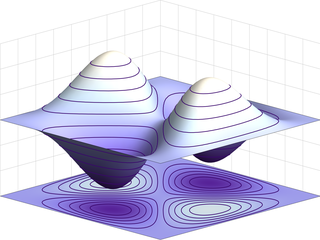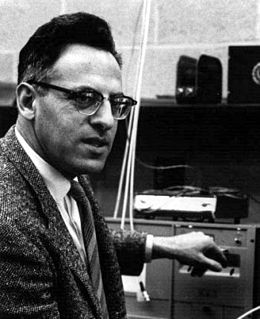
In particle physics, a fermion is a particle that follows Fermi–Dirac statistics. These particles obey the Pauli exclusion principle. Fermions include all quarks and leptons, as well as all composite particles made of an odd number of these, such as all baryons and many atoms and nuclei. Fermions differ from bosons, which obey Bose–Einstein statistics.

Particle physics is a branch of physics that studies the nature of the particles that constitute matter and radiation. Although the word particle can refer to various types of very small objects, particle physics usually investigates the irreducibly smallest detectable particles and the fundamental interactions necessary to explain their behaviour. By our current understanding, these elementary particles are excitations of the quantum fields that also govern their interactions. The currently dominant theory explaining these fundamental particles and fields, along with their dynamics, is called the Standard Model. Thus, modern particle physics generally investigates the Standard Model and its various possible extensions, e.g. to the newest "known" particle, the Higgs boson, or even to the oldest known force field, gravity.

The Standard Model of particle physics is the theory describing three of the four known fundamental forces in the universe, as well as classifying all known elementary particles. It was developed in stages throughout the latter half of the 20th century, through the work of many scientists around the world, with the current formulation being finalized in the mid-1970s upon experimental confirmation of the existence of quarks. Since then, confirmation of the top quark (1995), the tau neutrino (2000), and the Higgs boson (2012) have added further credence to the Standard Model. In addition, the Standard Model has predicted various properties of weak neutral currents and the W and Z bosons with great accuracy.

In particle physics, a lepton is an elementary particle of half-integer spin that does not undergo strong interactions. Two main classes of leptons exist, charged leptons, and neutral leptons. Charged leptons can combine with other particles to form various composite particles such as atoms and positronium, while neutrinos rarely interact with anything, and are consequently rarely observed. The best known of all leptons is the electron.

Frederick Reines was an American physicist. He was awarded the 1995 Nobel Prize in Physics for his co-detection of the neutrino with Clyde Cowan in the neutrino experiment. He may be the only scientist in history "so intimately associated with the discovery of an elementary particle and the subsequent thorough investigation of its fundamental properties".
The muon neutrino is a lepton, an elementary subatomic particle which has the symbol
ν
μ and no net electric charge. Together with the muon it forms the second generation of leptons, hence the name muon neutrino. It was first hypothesized in the early 1940s by several people, and was discovered in 1962 by Leon Lederman, Melvin Schwartz and Jack Steinberger. The discovery was rewarded with the 1988 Nobel Prize in Physics.
The electron neutrino is a subatomic lepton elementary particle which has zero net electric charge. Together with the electron it forms the first generation of leptons, hence the name electron neutrino. It was first hypothesized by Wolfgang Pauli in 1930, to account for missing momentum and missing energy in beta decay, and was discovered in 1956 by a team led by Clyde Cowan and Frederick Reines.
The W and Z bosons are together known as the weak or more generally as the intermediate vector bosons. These elementary particles mediate the weak interaction; the respective symbols are
W+
,
W−
, and
Z
. The
W±
bosons have either a positive or negative electric charge of 1 elementary charge and are each other's antiparticles. The
Z0
boson is electrically neutral and is its own antiparticle. The three particles have a spin of 1. The
W±
bosons have a magnetic moment, but the
Z0
has none. All three of these particles are very short-lived, with a half-life of about 3×10−25 s. Their experimental discovery was a triumph for what is now known as the Standard Model of particle physics.

Neutrino astronomy is the branch of astronomy that observes astronomical objects with neutrino detectors in special observatories. Neutrinos are created as a result of certain types of radioactive decay, or nuclear reactions such as those that take place in the Sun, in nuclear reactors, or when cosmic rays hit atoms. Due to their weak interactions with matter, neutrinos offer a unique opportunity to observe processes that are inaccessible to optical telescopes.

Neutrino oscillation is a quantum mechanical phenomenon whereby a neutrino created with a specific lepton family number can later be measured to have a different lepton family number. The probability of measuring a particular flavor for a neutrino varies between 3 known states, as it propagates through space.
Sterile neutrinos are hypothetical particles that interact only via gravity and do not interact via any of the fundamental interactions of the Standard Model. The term sterile neutrino is used to distinguish them from the known active neutrinos in the Standard Model, which are charged under the weak interaction.

DONUT was an experiment at Fermilab dedicated to the search for tau neutrino interactions. The detector operated during a few months in the summer of 1997, and successfully detected the tau neutrino. It confirmed the existence of the last lepton predicted by the Standard Model. The data from the experiment was also used to put an upper limit on the tau neutrino magnetic moment and measure its interaction cross section.

A neutrino detector is a physics apparatus which is designed to study neutrinos. Because neutrinos only weakly interact with other particles of matter, neutrino detectors must be very large to detect a significant number of neutrinos. Neutrino detectors are often built underground, to isolate the detector from cosmic rays and other background radiation. The field of neutrino astronomy is still very much in its infancy – the only confirmed extraterrestrial sources so far as of 2018 are the Sun and the supernova 1987A in the nearby Large Magellenic Cloud. Another likely source is the blazar TXS 0506+056 about 3.7 billion light years away. Neutrino observatories will "give astronomers fresh eyes with which to study the universe."
T2K is a particle physics experiment that is a collaboration between several countries, including Japan, Canada, France, Germany, Italy, South Korea, Poland, Russia, Spain, Switzerland, the United States, and the United Kingdom. It is the second generation follow up to the K2K experiment, a similar long baseline neutrino oscillation experiment.

The CERN Neutrinos to Gran Sasso (CNGS) project was a physics project of the European Organization for Nuclear Research (CERN). The aim of the project was to analyse the hypothesis of neutrino oscillation by directing a beam of neutrinos from CERN's facilities to the detector of the OPERA experiment at the Gran Sasso National Laboratory (LNGS), located in the Gran Sasso mountain in Italy. The CNGS facility was housed in a tunnel which diverged from one of the SPS–LHC transfer tunnels, at the Franco–Swiss border near Geneva. It used the Super Proton Synchrotron (SPS) accelerator as a source of high-energy protons.

In 2011, the OPERA experiment mistakenly observed neutrinos appearing to travel faster than light. Even before the mistake was discovered, the result was considered anomalous because speeds higher than that of light in a vacuum are generally thought to violate special relativity, a cornerstone of the modern understanding of physics for over a century.

Atsuto Suzuki is an experimental particle physicist known for his observations of neutrinos and anti-neutrinos.
The Giant Radio Array for Neutrino Detection (GRAND) is a proposed large-scale detector designed to collect ultra-high energy cosmic particles as cosmic rays, neutrinos and photons with energies exceeding 1017 eV. This project aims at solving the mystery of their origin and the early stages of the universe itself. The proposal, formulated by an international group of researchers, calls for an array of 200,000 receivers to be placed on mountain ranges around the world.













